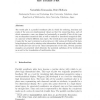105
Voted
HCI
2009
14 years 10 months ago
2009
Categorical data appears in various places, and dealing with it has been a major concern in analysis fields. However, representing not only global trends but also local trends of d...
106
Voted
SCFBM
2008
14 years 12 months ago
2008
Background: Genomics and proteomics analyses regularly involve the simultaneous test of hundreds of hypotheses, either on numerical or categorical data. To correct for the occurre...
102
click to vote
TVCG
2002
15 years 2 days ago
2002
Simple presentation graphics are intuitive and easy-to-use, but only show highly aggregated data. Bar charts, for example, only show a rather small number of data values and x-y-pl...
105
Voted
FSS
2008
15 years 15 days ago
2008
The grade of membership (GoM) model uses fuzzy sets as memberships of each individual to extreme profiles (or classes) on the likelihood function of multivariate multinomial distr...
95
Voted
CSDA
2008
15 years 16 days ago
2008
The textile plot is a parallel coordinate plot in which the ordering, locations and scales of the axes are simultaneously chosen so that the connecting lines, each of which repres...
111
Voted
CSDA
2010
15 years 16 days ago
2010
We propose a model for a point-referenced spatially correlated ordered categorical response and methodology for estimation of model parameters. Models and methods for spatially co...
142
Voted
PARMA
2004
15 years 1 months ago
2004
Abstract. Frequent itemsets and association rules are generally accepted concepts in analyzing item-based databases. The Apriori-framework was developed for analyzing categorical d...
114
Voted
SDM
2008
SIAM
15 years 1 months ago
2008
SIAM
Measuring similarity or distance between two entities is a key step for several data mining and knowledge discovery tasks. The notion of similarity for continuous data is relative...
104
Voted
HIS
2008
15 years 1 months ago
2008
This paper addresses the application of a PCA analysis on categorical data prior to diagnose a patients data set using a Case-Based Reasoning (CBR) system. The particularity is th...
141
Voted
IPMU
2010
Springer
15 years 2 months ago
2010
Springer
Abstract. Nonparametric predictive inference (NPI) is a powerful frequentist statistical framework based only on an exchangeability assumption for future and past observations, mad...

